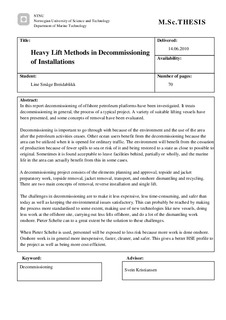| dc.description.abstract | In this report decommissioning of offshore petroleum platforms have been investigated. It treats decommissioning in general, the process of a typical project. A variety of suitable lifting vessels have been presented, and some concepts of removal have been evaluated.
Decommissioning is important to go through with because of the environment and the use of the area after the petroleum activities ceases. Other ocean users benefit from the decommissioning because the area can be utilized when it is opened for ordinary traffic. The environment will benefit from the cessation of production because of fewer spills to sea or risk of it and being restored to a state as close to possible to original. Sometimes it is found acceptable to leave facilities behind, partially or wholly, and the marine life in the area can actually benefit from this in some cases.
A decommissioning project consists of the elements planning and approval, topside and jacket preparatory work, topside removal, jacket removal, transport, and onshore dismantling and recycling. There are two main concepts of removal, reverse installation and single lift. The elements of the project are the same whichever of the concepts are used. The vessels to be used need large lifting capacities in either concept. Especially designs that lift topsides and jacket in single lifts can improve the efficiency in the projects.
Several lifting vessels have been presented and a few concepts were reviewed regarding future requirements. The concepts were platform removal using only a traditional HLV, topside removal using HLV and jacket removal using buoyancy tanks, and removal using the new lifting vessel design Pieter Schelte. It is found that all the concepts can remove fixed platforms, but Pieter Schelte was especially well-suited. When Pieter Schelte is used, personnel will be exposed to less risk because more work is done onshore. Onshore work is in general more inexpensive, faster, cleaner, and safer. This gives a better HSE profile to the project as well as being more cost-efficient. On the downside, the vessel is not available before 2013. In the meantime the alternative with the HLV and buoyancy tanks can gain some more experience. This alternative scored the same as removal with reverse installation and is therefore not so successful in this comparison. There are however uncertainties involved and the solution with the buoyancy tanks are still interesting.
The challenges in decommissioning are to make it less expensive, less time-consuming, and safer than today as well as keeping the environmental issues satisfactory. This can probably be reached by making the process more standardised to some extent, making use of new technologies like new vessels, doing less work at the offshore site, carrying out less lifts offshore, and do a lot of the dismantling work onshore. Pieter Schelte can to a great extent be the solution to these challenges. | nb_NO |
